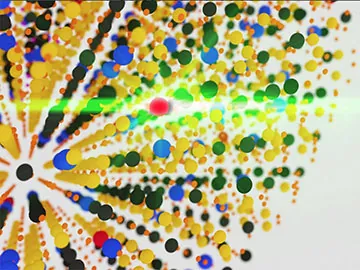
Revolutionary Nanosensors: Turning the Tables in Infrared Force Detection!
2025-01-08
Author: Wei
Revolutionary Nanosensors: Turning the Tables in Infrared Force Detection!
In an exciting breakthrough for the scientific community, researchers in the United States have developed infrared nanosensors that utilize the remarkable phenomenon of photon avalanching. This innovation enables the detection of tiny forces across a vast range, boasting an unprecedented level of sensitivity that could transform fields such as cellular biophysics and even space exploration (Nature, doi: 10.1038/s41586-024-08221-2).
What is Photon Avalanching?
Photon avalanching is a fascinating chain reaction where a single photon captured by specialized materials generates multiple photons at a higher frequency. This nonlinear behavior, intrinsic to elements in the lanthanide series of the periodic table, facilitates the detection of extremely weak signals. Historically, this process required bulk materials with a high concentration of lanthanide ions, limiting its applicability.
However, a research team led by Jim Schuck at Columbia University made waves in 2021 by successfully demonstrating photon avalanching using tiny 25-nm-diameter crystals of sodium yttrium fluoride, doped with high levels of thulium, a rare earth element. Their latest findings illustrate how these nanoparticles can serve as highly sensitive force detectors, revealing three distinct sensing methodologies based on varying concentrations of the doping element.
An Innovative Setup for Precise Measurements
The groundbreaking work, overseen by Natalie Fardian-Melamed at Columbia and conducted in partnership with Lawrence Berkeley National Laboratory and the University of Utah, employed a unique experimental setup. By combining an atomic force microscope (AFM) with an inverted optical microscope, the team subjected individual nanoparticles to infrared laser light while gently tapping them with the AFM's cantilever arm.
With this innovative approach, the researchers demonstrated detection capabilities over an extraordinary range—reporting sensitivity across four distinct orders of magnitude. This is 10 to 100 times greater than any previous optical nanosensor on record!
Unveiling the Sensing Potential
Their exploration revealed that by adjusting the yttrium ions replaced by thulium ions (between 4.5% and 8%), photon avalanching could occur without any external force. As the excitation intensity increased with the pump laser, the output intensity surged dramatically. Additionally, when the AFM was activated, changes in the excitation–emission curve disclosed remarkable force sensitivity, accurately measuring forces as low as 200 nanonewtons.
Moreover, the researchers probed the range of detection capabilities by applying varying forces (from 0 to 2.5 micronewtons) to observe how much each nanoparticle could sense. The results were astounding; all nanoparticles could detect forces across three orders of magnitude, with the laser pump's power dictating the limits of this range.
Measuring Minuscule Forces with Precision
By carefully calibrating the concentration of thulium, the researchers enhanced the system's resolution. Particles with a reduced dopant concentration of 4% did not demonstrate photon avalanching alone. However, when subjected to force via the AFM, they exhibited a characteristic nonlinear rise in emission intensity, effectively allowing the detection of forces as diminutive as 475 piconewtons—an impressive feat compared to the 620 piconewtons achieved with higher thulium concentrations.
In a fascinating twist, the researchers also explored what they termed “piezochromic” sensors, which with increased thulium concentration of 15%, exhibited photon avalanching at two different wavelengths (800 nm and 700 nm). Strikingly, applying force resulted in a significant shift in the emission ratio, enhancing resistance to environmental interference, a common challenge in sensor calibration.
A Paradigm Shift in Sensing Technologies
According to Schuck, this groundbreaking research is poised to "transform the paradigm of sensing." The ability to detect sensitive and dynamic measurements of forces and pressures in complex systems previously deemed unreachable can propel various applications. Speculative examples include energy storage systems, the mechanics of migrating cells, and even the dynamic forces at play during embryonic development.
While the prospects are promising, the team acknowledges challenges ahead, such as nanoparticle variability and sensitivity to external factors like temperature fluctuations. However, they believe that their piezochromic concept may offer a solution, potentially leveraging other lanthanide elements to improve performance and ensure calibration accuracy.
Conclusion: Setting the Stage for Future Innovations
With their groundbreaking findings, the research team is set to redefine the boundaries of force and pressure measurement technologies. As the scientific community eagerly anticipates further developments, these nanosensors could very well pave the way for crucial advancements in multiple disciplines. Stay tuned, as the world of nanosensing is only just beginning to unveil its potential!

 Brasil (PT)
Brasil (PT)
 Canada (EN)
Canada (EN)
 Chile (ES)
Chile (ES)
 Česko (CS)
Česko (CS)
 대한민국 (KO)
대한민국 (KO)
 España (ES)
España (ES)
 France (FR)
France (FR)
 Hong Kong (EN)
Hong Kong (EN)
 Italia (IT)
Italia (IT)
 日本 (JA)
日本 (JA)
 Magyarország (HU)
Magyarország (HU)
 Norge (NO)
Norge (NO)
 Polska (PL)
Polska (PL)
 Schweiz (DE)
Schweiz (DE)
 Singapore (EN)
Singapore (EN)
 Sverige (SV)
Sverige (SV)
 Suomi (FI)
Suomi (FI)
 Türkiye (TR)
Türkiye (TR)
 الإمارات العربية المتحدة (AR)
الإمارات العربية المتحدة (AR)